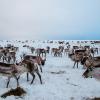
Options Winter 2021: The integrity of traditional reindeer husbandry in Finland is under threat. In a study that analyzed the perceptions of herders on the drivers of change in reindeer management, IIASA researcher Mia Landauer and colleagues hoped to amplify local voices so they can be included in future policy decisions.
Reindeer husbandry is a traditional livelihood for many indigenous Saami and Finnish people in northern Finland, where it provides a vast array of social, cultural, and economic benefits. The modern-day pressures of climate change, economic development, and competing forms of land-use, however, are posing challenges to the integrity of the reindeer management system.
There are various public authorities that steer reindeer management through the changing times. Even though reindeer herders are the central actors in the system, they are often not able to influence the policies pertaining to their livelihood. To help manage future environmental conflicts, in a recent IIASA collaboration, researchers surveyed how herders perceive the drivers of change in reindeer management, along with how these perceptions vary with the diverse land-use and climate patterns found in different herding regions. The crucial factors for most herders were those that directly affected the welfare of reindeer and calving success, such as the amount of ice on pastures or the presence of other land-use forms that influence reindeer foraging and the daily work of herders due to the fragmentation of pastures. Herders had varying or polarized opinions on other factors, showcasing the regional differences in reindeer management.
“Awareness of reindeer management is low on the governance level. With this study, we hope that local voices will be better heard and included in future policy decisions,” says Mia Landauer, a researcher at IIASA and the Arctic Centre at the University of Lapland.
By Fanni Daniella Szakal